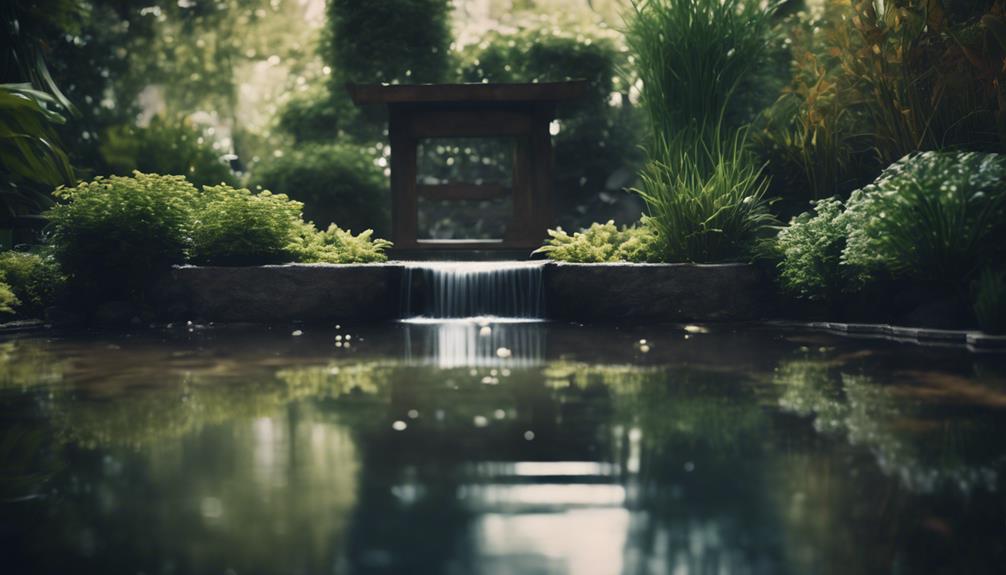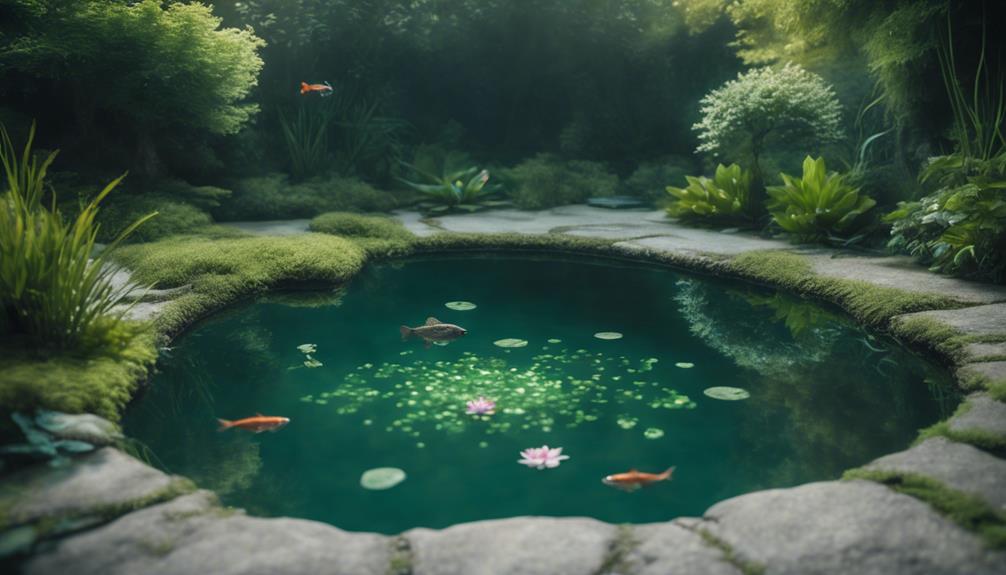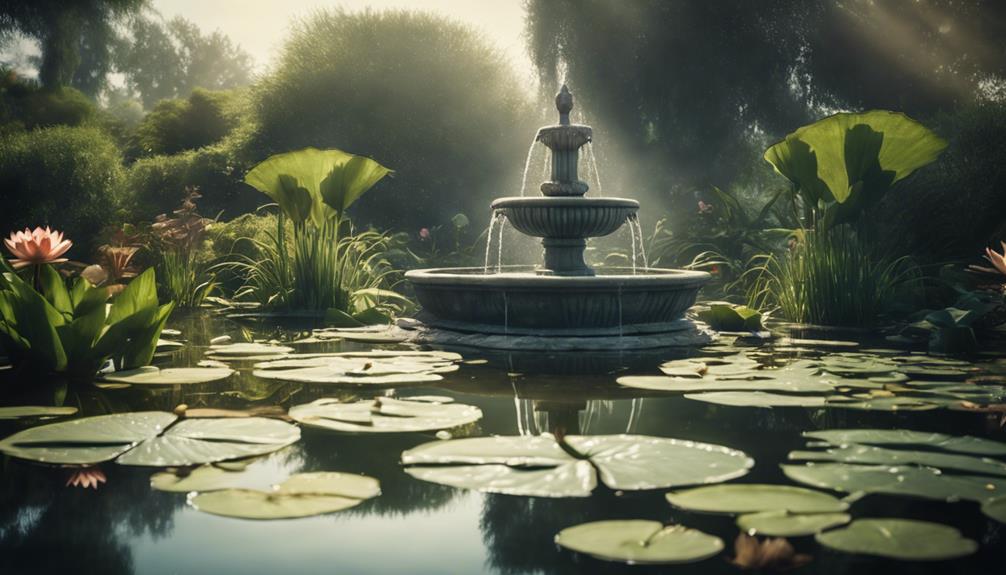You require a well-balanced ecosystem to maintain pristine water quality in your garden pond, which involves regularly monitoring and controlling key water quality parameters, balancing fish and plant life, and implementing effective filtration and maintenance systems. Regular water testing helps identify problems early, allowing for corrective action to maintain a healthy ecosystem. Keep pH levels between 7.2-8.5, oxygen levels above 4 ppm, and monitor ammonia, nitrite, and nitrate levels. Don't overpopulate with fish, and maintain a balanced plant population. By following these guidelines, you'll be well on your way to achieving crystal-clear water – and there's more to explore to fine-tune your pond's ecosystem.
Table of Contents
Key Takeaways
- Regular water testing is crucial to monitor pH, ammonia, nitrite, and nitrate levels, ensuring a healthy pond ecosystem.
- A balanced fish population, with no more than 10 fish per 100 gallons, prevents over-population and maintains water quality.
- Introducing aquatic plants that absorb nitrates and shade the water helps control algae growth and enhance the ecosystem.
- Implementing an effective filtration system, including mechanical, biological, and UV clarifiers, achieves exceptional water quality.
- Regular maintenance, including cleaning the filter and removing debris, is necessary for peak performance and pristine water quality.
Understanding Water Quality Parameters
When it comes to maintaining a thriving pond ecosystem, grasping the intricacies of water quality parameters is essential, as they've a direct impact on the health and well-being of both fish and plants.
You'll want to verify your pond's pH levels are within the ideal range of 7.2-8.5, as extreme values can be detrimental to aquatic life.
Regular water testing is vital to monitor pH levels, as well as dissolved oxygen levels, which should be above 4 ppm to support fish health and pond productivity.
You'll also need to keep tabs on ammonia, nitrite, and nitrate levels, aiming for 0 ppm for the first two and less than 40 ppm for the latter.
Water temperature is another critical factor, with ideal conditions ranging from 65-85°F (18-29°C).
Balancing Fish and Plant Life
To maintain a thriving pond ecosystem, you need to strike a delicate balance between fish and plant life, as an imbalance in either can have far-reaching consequences for water quality.
A balanced fish population is vital, so don't exceed 10 fish per 100 gallons of water to prevent over-population and imbalance. Excessive fish waste can cause issues, so consider rehoming excess fish to maintain a healthy population.
When it comes to plants, aim to cover 40-60% of the pond's surface area to avoid oxygen deficiencies at night. Remember, plants take in oxygen and give off carbon dioxide, affecting fish oxygen supply, so balancing plant life is necessary to maintain a healthy ecosystem.
Effective Pond Filtration Systems

As you consider effective pond filtration systems, you'll want to explore the various options that can help maintain superior water quality.
You'll need to evaluate mechanical filter media, which physically remove debris, as well as biological filter types, which harness beneficial bacteria to break down waste.
Additionally, you'll want to weigh the benefits of UV clarifiers, which can help control algae growth and improve water clarity.
Mechanical Filter Media
By incorporating mechanical filter media, such as foam pads or bio-balls, into your pond's filtration system, you create a physical barrier that traps debris and waste, allowing beneficial bacteria to colonize and break down organic matter. This vital step in maintaining pristine water quality in your garden pond guarantees a clean and healthy environment for your aquatic life.
To get the most out of your mechanical filter media, keep the following in mind:
Effective particle capture: Look for media that can capture particles as small as 10-20 microns for superior water clarity and quality.
Customize your setup: The type and quantity of mechanical filter media you need will depend on your pond's size, fish population, and water flow rates.
Regular maintenance: Clean your mechanical filter media weekly or bi-weekly to prevent clogging and promote peak performance.
Combine with biological filtration: By pairing mechanical filter media with biological filtration, you can achieve exceptional water quality and a thriving ecosystem.
Biological Filter Types
You can further enhance your pond's filtration system by incorporating a biological filter, which harnesses the power of beneficial bacteria to break down ammonia and nitrite into harmless compounds. This type of filter is vital for maintaining good water quality and a healthy ecosystem in your pond.
There are three main types of biological filters: submerged filters, external filters, and pressurized filters. Each type has its own advantages and disadvantages, so selecting the right one for your pond's specific needs is vital.
Biological filters can be further divided into aerobic and anaerobic filters, which differ in their oxygen requirements.
To guarantee peak performance, regular cleaning and maintenance of the biological filter are necessary. A well-maintained filter can remove up to 99% of ammonia and nitrite, resulting in crystal-clear pond water and a thriving ecosystem.
UV Clarifier Benefits
Incorporating a UV clarifier into your pond's filtration system can substantially enhance water clarity and overall ecosystem health by controlling algae growth and eliminating excess nutrients.
This effective pond filtration system uses ultraviolet light to clarify water, making it an essential component of a well-maintained garden pond.
Four key benefits of using a UV clarifier in your pond are:
Eliminate Algae Blooms: By exposing algae to UV light, you can eliminate up to 99.9% of algae cells, resulting in clearer water and a healthier ecosystem.
Break Down Excess Nutrients: UV clarifiers are especially beneficial in ponds with high fish populations or those that receive direct sunlight, as they help to break down excess nutrients that can contribute to algae blooms.
Thorough Water Treatment: When used in conjunction with other filtration systems, such as biological filters and mechanical filters, a UV clarifier can provide thorough water treatment and maintain peak water quality.
Easy Maintenance: Regular maintenance of a UV clarifier, including replacing the UV lamp every 6-12 months, is vital to its effectiveness in controlling algae growth and maintaining pristine water quality.
Regular Maintenance and Cleaning
Every week, remove debris and excess plant growth from the pond's surface to prevent decaying matter from affecting water quality. Regularly clean your pond by skimming the surface and removing any dead plants or algae. This will help prevent excess nutrients from building up and causing water quality issues.
Proper water circulation is vital in maintaining pristine water quality. Make sure your pump is working efficiently and that water is circulating properly throughout the pond. Keep Pond Water clean by performing partial water changes regularly. This will help remove built-up toxins and maintain a healthy environment for your aquatic life.
Don't forget to clean your filter regularly to confirm it's working efficiently. A clogged filter can lead to poor water quality, so make sure to check and clean it according to the manufacturer's instructions. By following these simple steps, you'll be able to Maintain water quality and keep your pond clean and healthy. Remember, regular Pond Maintenance is key to preventing water quality issues and keeping your pond thriving.
Natural Solutions for Water Clarity

Natural solutions can greatly improve water clarity in your pond by leveraging the power of aquatic plants, beneficial bacteria, and other eco-friendly methods to maintain exceptional water quality. By introducing these natural solutions, you can create a thriving water garden that's teeming with life and free from poor water quality.
Aquatic Plants: Introduce plants that eat up diverse types of nitrates, preventing algae growth and enriching the ecosystem. Aim for 40-60% coverage of the water surface area.
Beneficial Bacteria: Add beneficial bacteria to fight against single-celled algae and consume nitrites, improving water quality. You can add them through supplements or introduce plants that naturally produce them.
Effective Filtration: Implement an effective filter system offering mechanical, aerobic biological, and anaerobic biological filtration to remove excess nutrients and maintain optimal water quality.
Nutrient Control: Use substances like bentonite clay or aluminum sulfate to bind with nutrients in the water, keeping levels under control and improving water clarity.
Managing Pond Ecosystem Dynamics
By recognizing the intricate relationships between living organisms, water chemistry, and physical environment, you can effectively manage pond ecosystem dynamics to maintain ideal water quality and a thriving aquatic environment.
To achieve this, you'll need to examine both living and non-living components within your pond. Managing fish populations is essential, as excess nutrients from fish waste can lead to poor water quality. Introducing plant life helps absorb nutrients and shade the water, controlling algae bloom. Beneficial bacteria also play a pivotal role in breaking down organic matter and maintaining ecosystem balance.
As you work towards ecosystem balance, remember that microbial processes, wildlife population, and species composition are all interconnected.
Your pond pump and water features can also impact dissolved oxygen levels, which are essential for a healthy pond ecosystem. By understanding these dynamics, you can make targeted interventions to improve water quality.
Regular pond maintenance is key to ensuring your pond remains a haven for aquatic life. By taking a holistic approach to managing your pond ecosystem, you'll be rewarded with crystal-clear water and a thriving ecosystem that brings joy and serenity to your outdoor space.
Identifying and Solving Water Issues

Test your pond water regularly to detect potential issues before they threaten the health of your aquatic ecosystem. Regular monitoring helps you identify problems early, and take corrective action to maintain pristine water quality.
Some common water issues to look out for:
- pH fluctuations: sudden changes can stress or kill fish, so maintain a stable pH range of 7.2-8.5.
- Excess nutrients: overfeeding or poor filtration can lead to algae growth, deplete oxygen levels, and harm aquatic life.
- Ammonia and nitrite spikes: these toxic compounds can be lethal to fish, so keep levels in check.
- Oxygen depletion: maintain adequate oxygen levels by sustaining a balanced ecosystem and providing sufficient aeration.
Advanced Water Quality Improvement Methods
As you move forward with maintaining your pond's water quality, you'll want to explore advanced strategies to optimize its health.
You'll need to examine oxygenation methods that boost your pond's dissolved oxygen levels, supplement with beneficial bacteria to break down organic matter, and regularly test your water to identify areas for improvement.
Oxygenation Strategies
Implementing effective oxygenation strategies is essential to maintaining a healthy and thriving pond ecosystem, especially during periods of warm weather when dissolved oxygen levels tend to decline.
As a pond owner, you want to maintain your pond's water quality at its best, and oxygenation plays a critical role in achieving this.
Install an aeration system: A pond aerator can increase dissolved oxygen levels by up to 30% and reduce water temperature stratification, creating a healthier environment for fish and other aquatic organisms.
Add oxygen-releasing plants: Incorporating plants like hornwort or water wisteria into your pond can provide a natural source of oxygenation and help maintain water quality.
Monitor dissolved oxygen levels: Regular water testing can help identify oxygenation issues and inform the implementation of effective oxygenation strategies.
Improve water circulation: Aeration systems can also help increase water circulation, reducing the accumulation of nutrients that fuel algae blooms and improving overall water quality.
Bacterial Supplement Use
You can take your pond's water quality to the next level by utilizing bacterial supplements, which introduce beneficial microorganisms that break down organic matter and excess nutrients, promoting a balanced ecosystem.
These supplements contain bacteria specifically designed to thrive in aquatic environments, efficiently consuming waste products and excess nutrients that can harm your pond's water quality.
By adding a bacterial supplement to your pond, you'll create an ideal environment for beneficial bacteria to flourish, allowing them to break down decaying matter and maintain a healthy balance of nutrients.
This, in turn, will keep your pond water crystal clear and promote the overall health of your aquatic ecosystem.
Water quality is essential for maintaining a thriving pond ecosystem, and bacterial supplements can be a highly effective tool in achieving this goal.
Regular Water Testing
Regular water testing is essential for identifying subtle changes in your pond's water chemistry, allowing you to take prompt corrective action to prevent water quality issues from escalating into major problems.
By regularly monitoring your pond's water, you'll be able to detect even slight changes in water volume, levels of dissolved oxygen, and other key parameters.
Some key water quality parameters to test for:
- Dissolved Oxygen (DO): Verify levels are above 5mg/L to support beneficial bacteria and aquatic life.
- pH and Ammonia: Monitor for sudden changes that can indicate water quality issues.
- Nitrite and Nitrate: Track these parameters to confirm your pond's nitrogen cycle is functioning properly.
- Phosphorus: Test for excessive levels, which can contribute to algae growth and poor water quality.
Frequently Asked Questions
How Do I Keep My Backyard Pond Water Clear?
To keep your backyard pond water clear, you'll want to focus on pond aeration for proper water circulation, algae control, and regular filter maintenance, while also considering pond depths, water testing, and chemical balance to support thriving aquatic life.
How Do You Maintain the Quality of Water in a Pond?
You maintain water quality by boosting pond aeration and circulation, introducing beneficial bacteria, controlling algae, monitoring nitrate levels, using efficient pond filters, and regularly testing water, while also incorporating phosphate removal and aquatic plants.
How Do I Keep My Natural Pond Healthy?
Imagine a serene pond in a Japanese garden, teeming with life. To keep your natural pond healthy, you'll want to maintain pond aeration, water circulation, and beneficial bacteria, while sustaining a balanced fish population, aquatic plants, and suitable pond depth and water temperature.
How to Keep Lotus Pond Clean?
You'll keep your lotus pond clean by selecting suitable lotus varieties, optimizing pond placement for water aesthetics, and providing aquatic companions, while ensuring lotus nutrition, seasonal maintenance, algae management, water circulation, and efficient filtration systems.
Conclusion
As you gaze upon your thriving garden pond, remember that maintaining pristine water quality is a delicate balancing act.
Like a master conductor, you must harmonize the intricate symphony of water parameters, filtration systems, and ecosystem dynamics.
By following these expert guidelines, you'll create a crystal-clear oasis that's teeming with life.
Now, take the reins and orchestrate a pond that's a true masterpiece of aquatic harmony.

